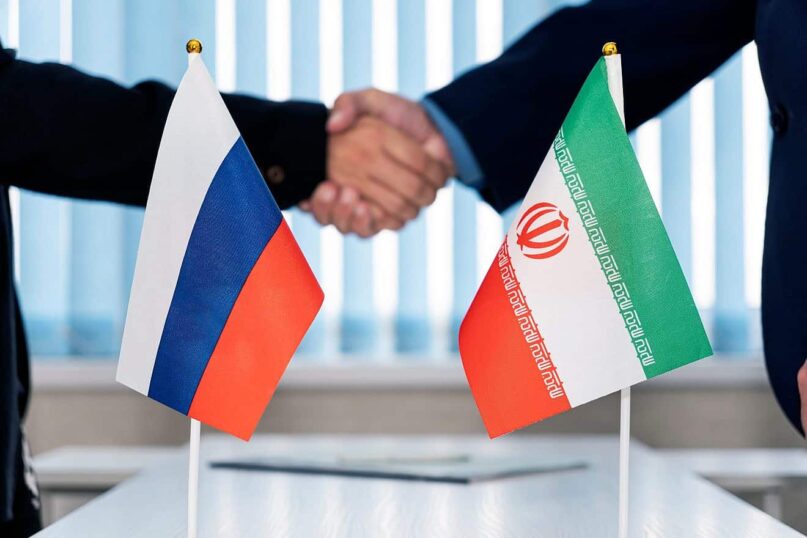
A Moscow turn against Jerusalem cannot be discounted.
By Ben Cohen
(JNS) “The Russian-Iranian partnership still has room to grow.” That, in essence, is the conclusion of a sober, dispassionate report probing relations between Russia and Iran that was published last week by the RAND Corporation.
The report is an important, factually based contribution to our understanding of how the Moscow-Tehran connection is evolving, and the consequent implications for the United States, for Israel and for the Western alliance system. Critically, it makes the case persuasively that while relations between Russia and Iran have grown alarmingly close as the invasion of Ukraine has intensified, particularly in the sphere of military cooperation, we are not dealing with a “strategic partnership” but a “transactional relationship” whose benefits at present decisively outweigh any disadvantages.
Before looking in greater detail at the nature and focus of Russian-Iranian relations, it’s worth examining the report’s answer to the question as to why the two countries have not (yet) entered into a formal alliance. There are several layers here. Historically, relations between them have been marred by distrust, with many Iranians perceiving Russia as a territorial predator poised on the other side of the Caspian Sea. After the Islamist revolution in Iran in 1979, relations with the Soviet Union were tense, with Moscow angered by the Iranian regime’s persecution of Communist elements and Tehran furious with Russia’s decision to arm Iraq during its brutal 1980-88 war with its eastern neighbor. However, towards the end of the 1980s, Iranian leaders began rethinking their strategy, anxious to counterbalance U.S. influence in the Middle East and eager to improve their access to commodities and technology for domestic use.
The diplomatic fruits of that shift quickly became clear. During the 1990s, Iran and Russia cooperated in Afghanistan and Tajikistan, while Iran hypocritically turned a blind eye to the Russian slaughter of thousands of Muslims in the Republic of Chechnya. But there were also points of difference, for example in the Balkans, where the Iranians backed the mainly Muslim government during the war in Bosnia, while Russia enthusiastically supported the Serb insurgents.
Over time, however, Russia and Iran have discovered that there is much more that binds them together than forces them apart. As the RAND report makes clear, the disagreements and misunderstandings between them are real, but not significant enough to derail the forging of closer ties during the last 18 months.
The most dangerous aspect of the relationship concerns the transfer of weapons between the two countries in both directions. Iran has supplied Russia with thousands of Shahed-136 and Mohajer-6 drones that have been used to devastating effect against Ukraine’s civilian infrastructure, as well as receiving “shipments of ammunition, mortars, machine guns, spare airplane and motor vehicle parts, and other military equipment and supplies transported via the Caspian Sea.” In turn, Russia has promised to supply the Iranians with a fleet of Sukhoi-35 fighter jets as early as next year. Additionally, the Russian and Iranian navies have carried out joint exercises in the Gulf of Oman, frequently involving their Chinese counterparts as well. Moreover, as authoritarian states bent on crushing every expression of dissent, Russia and Iran have benefited from the sharing of surveillance technology, with Russian engineers reportedly aiding the Iranians in securing their networks in cyberspace.
The report is in no doubt that “a strengthened partnership has benefitted both countries by influencing the course of the war in Ukraine and recasting Iran as an arms supplier—rather than client—in the relationship.” And while it is “too soon to declare the beginning of a new era for the Russian-Iranian relationship,” the report argues, “it is time to begin thinking about what closer ties between the two states might mean for U.S. operations and strategy.”
Which brings us to the issue of Israel. As far as the RAND report is concerned, this is a major point of difference between the two countries, with Russia continuing to engage with Israel and conservative Gulf Arab states like the United Arab Emirates and Saudi Arabia, while Iran backs terrorist groups like Hezbollah in Lebanon and the Houthi militias in Yemen that are a major source of instability. It argues as well that Russia is likely to take seriously Israel’s repeated threats to destroy Iran’s nuclear-weapons capability before it develops one, at the same time reluctant to jettison its relations with Jerusalem in the event of a conflict.
Again, there is a great deal of merit to that insight, but it’s vital to remember that the situation is fluid and that current imperatives mean that closer Moscow-Tehran ties are more likely, not less. Additionally, strategic analysis generally plays down or ignores outright the role of ideas and ideology in policymaking; in the Russian case, that’s a mistake. Prior to the Communist revolution over a century ago, Russia was a credible candidate for the title of “most antisemitic country in the world,” while during the Soviet era, Israel was viciously demonized in official propaganda, with its leaders depicted as Nazis in much the same way as Ukraine’s democratic government is right now.
In the months that have elapsed since the invasion of Ukraine, Russia’s relations with Israel have soured even as Israel has been supremely careful to stay out of the military aspects of that conflict, restricting its role to the supply of humanitarian aid. Over that period, the Russian authorities have made efforts to shutter the Moscow office of the Jewish Agency, which aids new immigrants in Israel. Russian leaders, including Foreign Minister Sergey Lavrov and President Vladimir Putin, have made unpleasant, provocative comments on a number of occasions, depicting Ukrainian President Volodymyr Zelenskyy as a tame Jew carrying out the orders of his Nazi overlords, falsely claiming that Ukraine plans to do to ethnic Russians what the Nazis did to the Jews, and asserting, as Lavrov did rather delightedly, that the worst antisemites are Jews and that Adolf Hitler had “Jewish blood.”
Against this background, a Russian turn against Israel, with its echoes of the Cold War, cannot be discounted. The RAND report is a timely reminder of the enormous stakes at play in Ukraine—stakes that are increasingly camouflaged by the growing Ukraine war fatigue among U.S. politicians and in several European countries, which we can be sure both the Russians and the Iranians will happily exploit.
Ben Cohen writes a weekly column for JNS on Jewish affairs and Middle Eastern politics. His writings have been published in the New York Post, The Wall Street Journal, Commentary, Haaretz and many other publications.
PHOTO: Flags
CAP: Flags of Russia and Iran on a table in an international negotiation room. Credit: Melnikov Dmitriy/Shutterstock.








 Southern New England Jewish Ledger
Southern New England Jewish Ledger








